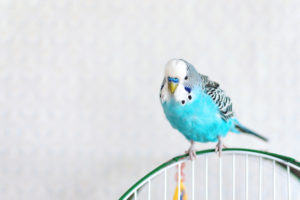To the majority of bird owners, the appearance of an egg can be quite a surprise. First of all, it’s hard to know the sex of your pet bird unless you get it tested, so there’s a fifty percent chance you thought you had a male bird and were wrong! Secondly, many of us presume that if we just have the one bird, it can’t reproduce.
And therein lies the confusion, as a female bird indeed cannot reproduce unless its egg becomes fertilized by a male. However, in this context, female birds are similar to women, in that they will still ovulate regularly, irrespective of the presence of a male. Therefore, they are all capable of laying eggs. So, while this is a perfectly natural phenomenon rather than a concern, it can easily become dangerous, with the most common risk being egg binding, or dystocia.
Binding is determined by a bird being unable to deliver an egg within a reasonable timeframe (usually around 48 hours), causing it to retain the egg in the reproductive tract. Unfortunately for parrot-lovers, the Psittacine species seem unusually susceptible to this condition, especially cockatiels, lovebirds and budgerigars, and to a lesser-extent, canaries and finches. Common backyard poultry (chickens, ducks, geese and turkeys) can also be affected. The failure to be able to expel an egg should be considered an emergency that requires immediate veterinary attention.

There are a few causes, the most frequent of which is a deficiency in calcium, which is an important part of a bird’s mineral requirements needed for the formation of a proper shell. This is usually through the lack of a properly balanced diet, which can also lead to another cause, obesity. This is especially true for caged birds that lack the physical exercise available to aviary pets, eroding the strength and stamina required to push out an egg. Another factor can be age, with both very young and/or old birds most affected.
Finally, if your bird is producing a large number of eggs, do not make the mistake of thinking it is immune to this problem. Excessive egg production can lead to secondary uterine inertia, also resulting in egg binding. Again, diet can be a major contributing factor, as the stress and demands of producing eggs depletes a bird’s mineral resources unless they are supplemented beyond its normal diet.
Because even egg-laying birds can suffer from dystocia, detection is by no means straight-forward. But there are some tell-tale signs to look out for: An enlarged abdomen should be the most obvious; labored breathing from pressure on their airways; weakness or even partial paralysis in its legs causing a lack of balance (often recognized by a reluctance to go on the perch); tail wagging; and depression, which can also be a warning sign for many other illnesses.
For diagnostic confirmation, an X-ray is often required, or even an ultrasound (sonogram) for soft- or non-shelled eggs, suggesting the best course of action is to head straight to an avian Vet. Early diagnosis is essential, especially for smaller birds, which can die within a matter of hours should a retained egg compromise their circulation or breathing. For this reason, critically ill birds are first treated for shock, before any attempt is made to extract the egg.
“Egg binding is a serious and potentially life-threatening condition, and the occasional bird will not survive the shock,” said Dr. Mark Simpson, owner of the Sugarloaf Animal Hospital and a specialist in avian treatment for more than 20 years. “But if we can treat them early and aggressively, the majority of birds will pass the egg and make a complete recovery.”
Once stable, there are a number of methods to provide relief, either supportive or surgical. Almost all should start by administering calcium for one or two days, either intramuscularly, or via diet. If the bird is kept in a warm, humid environment and given lots of fluids and lubrication, this may be sufficient to induce delivery, or at least allow a successful expulsion via manual manipulation.
If not, the next option is to aspirate the egg internally: Using a syringe, the egg can be punctured and the contents removed, which will cause the egg to implode. Shell fragments should work their way out over the next two to three days, so an antibiotic treatment is recommended to reduce the risk of infection. Medicinal treatment is possible to induce delivery, using either oxytocin or prostaglandin (as with human females.) However, these are not avian hormones and carry additional risk.
For more difficult cases, surgical intervention may be necessary to remove the egg via the abdomen (laparotomy) at which time your Vet may also consider performing a salpingectomy, where a portion of the oviduct is removed to prevent another shelled egg from being formed, even though the ovary still functions. (Incidentally, a laparotomy can also be used to determine the sex of your bird, should you wish to discover whether egg binding is a risk.)
As with many problems, the best cure is prevention, which can be addressed most effectively through environment to try to stem the problem at source by deterring egg-laying. In the wild, the advent of spring brings longer days and shorter nights, signaling the ideal breeding season. However, in a captive environment, artificial light circumvents dusk, potentially prolonging the egg-laying cycle. Simply creating a longer period of complete darkness by the use of a heavy cover for up to 16 hours a day will simulate winter conditions and inhibit reproductive urges.
If your bird has already become broody, it will be apparent in its behavior, such as overly friendly interaction with its mirror or toys, which can become objects of desire, or unusually aggressive demonstrations such as screeching or biting. The solution is simple: Take away the favorite object and reduce interaction, especially handling and petting. In general, anything that changes or upsets a bird’s routine and surroundings is likely to cause enough discomfort to disrupt the cycle.
Should these remedies not have the desired effect and you discover one or more eggs, there’s a school of thought that suggests allowing them to accumulate. Letting the bird tend to those eggs should deter her from producing more. Removal may simply encourage the bird to lay more eggs to replace those that go missing.
Also, it’s important to remember that egg-laying in itself is not the problem, whereas egg binding is. So, once an egg appears, keeping your bird healthy is the main goal, with nutrition being the key factor. Shell creation depletes calcium levels, so even a well-balanced diet needs to be supplemented. Popular seed mixes often contain a preponderance of fat while lacking necessary protein and vitamins. Even the best ones allow for selective feeding from fussy eaters. Apart from just having a cuttlebone in the cage, extra calcium can be introduced by adding shavings into food or using a mineral supplement in the drinking water.
Egg-laying is tiring work – don’t let it become a bind.






